
The Crassulaceae, also known as the stonecrop family or the orpine family, are a diverse family of dicotyledon flowering plants characterized by succulent leaves and a unique form of photosynthesis, known as Crassulacean acid metabolism (CAM). Flowers generally have five floral parts. Crassulaceae are usually herbaceous but there are some subshrubs, and relatively few treelike or aquatic plants. Crassulaceae are a medium size monophyletic family in the core eudicots, among the order Saxifragales, whose diversity has made infrafamilial classification very difficult. The family includes approximately 1,400 species and 34–35 genera, depending on the circumscription of the genus Sedum, and distributed over three subfamilies. Members of the Crassulaceae are found worldwide, but mostly in the Northern Hemisphere and southern Africa, typically in dry and/or cold areas where water may be scarce, although a few are aquatic.

The horned lark, called the shore lark in Europe, is a species of lark in the family Alaudidae found across the northern hemisphere.
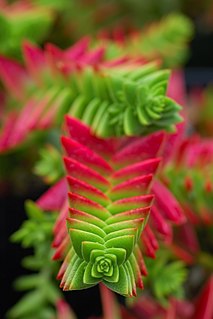
Crassula is a genus of succulent plants containing about 200 accepted species, including the popular jade plant. They are members of the stonecrop family (Crassulaceae) and are native to many parts of the globe, but cultivated varieties originate almost exclusively from species from the Eastern Cape of South Africa.

Crassula multicava is a perennial succulent plant from the family Crassulaceae. It is also known under various common names including the fairy crassula, pitted crassula and London pride.

Crassula tetragona is a succulent plant native to Southern Africa. It is widely distributed from the Orange River boundary of Namaqualand to beyond the Kei River in the Eastern Cape. "Tetragona" comes from the phyllotaxy of the leaves. It is popularly named the "miniature pine tree" among ornamental plant enthusiasts, for its popular use as a "pine tree" in Bonsai.
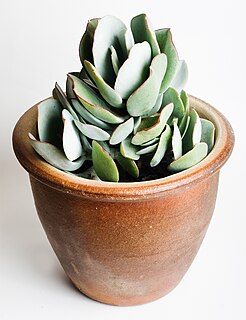
Crassula arborescens, the silver jade plant, silver dollar plant, beestebul, Chinese jade, money plant, or money tree, is a species of succulent plant in the family Crassulaceae. It is an endemic plant of the Western Cape, South Africa. It is a 2 to 4 ft succulent shrub. It has round gray "Silver Dollar" leaves. It blooms in winter, with white to pink flowers. It is cultivated as an ornamental plant for use in drought tolerant and succulent gardens, and in container gardens. It is also suitable for growing indoors as a houseplant.

Crassula muscosa, synonyms Crassula lycopodioides and Crassula pseudolycopodioides, is a succulent plant native to South Africa and Namibia, belonging to the family of Crassulaceae and to the genus Crassula. It is a houseplant grown worldwide and commonly known as rattail crassula, watch chain, lizard's tail, zipper plant and princess pines.

Princess pine may refer to:

Crassula marnierana, common name Jade Necklace or Chinese Pagoda, is a species of succulent in the genus Crassula belonging to the family Crassulaceae.
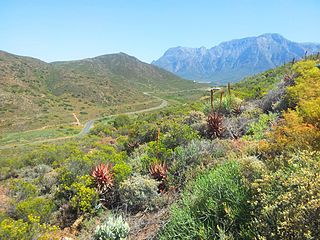
Robertson Karoo is a semi-arid vegetation type, restricted to sections of the Breede River Valley, Western Cape Province, South Africa. It is a subtype of Succulent Karoo and is characterised by the dominance of succulent plant species, and by several endemic plants and animals.
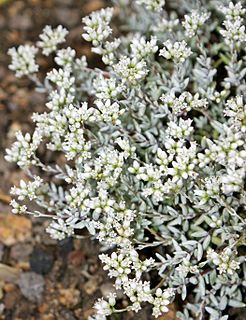
Crassula biplanata is a succulent plant native to rocky ledges and mountainous areas in the southern parts of South Africa.

Crassula alba is a species of flowering plant in the genus Crassula found in western Africa ranging from South Africa to Sudan.
Crassula alstonii is a species of succulent in the genus Crassula found in Cape Provinces, South Africa.The species is in USDA hardiness zone 10a-11.
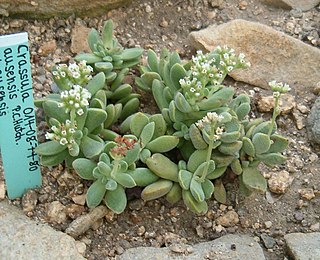
Crassula ausensis is a species of succulent in the genus Crassula found in Namibia. Crassula ausensis subsp. giessii and Crassula ausensis subsp. titanopsis are varieties of the species.

Crassula barbata, also known as the bearded-leaved crassula, is a species of flowering plant in the genus Crassula found in South Africa. Crassula barbata subsp. broomii is a subspecies, also found in South Africa.
Crassula clavata, is a species of succulent plant in the genus Crassula found in Cape Province, South Africa.

Crassula perfoliata is the type species of the nominative genus, Crassula, of the family Crassulaceae, where it is placed in the subfamily Crassuloideae. It was first formally described by Linnaeus in 1753 as one of 10 species of Crassula. It is a perennial, from S Africa.

Protea recondita, also known as the hidden sugarbush, is a flowering plant of the genus Protea within the family Proteaceae, which is endemic to the Cape Region of South Africa, and distributed from the Piketberg and Cederberg to the Groot Winterhoek mountains. The flowers of this unusual plant are pollinated by non-flying mammals: rodents and elephant shrews. In the Afrikaans language it is known as gesigtoehouprotea or skaamroos.

Protea canaliculata, also known as the groove-leaf sugarbush, is a species of flowering shrub of the genus Protea, which is endemic to the Cape Provinces of South Africa.

















